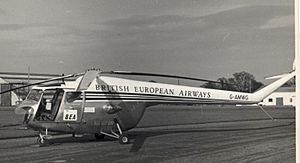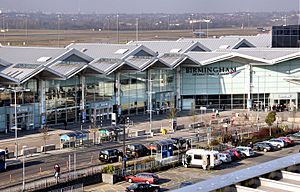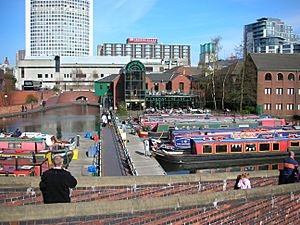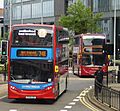Transport in Birmingham facts for kids
Birmingham is a major transport hub, due in part to its location in central England. The city is well connected by rail, road, and water. Public transport and key highways in the city are overseen by Transport for West Midlands (TfWM).
Air
History

Birmingham's first airport was Castle Bromwich Aerodrome, which operated from 1909–1958. Another opened as Elmdon Airport on 8 July 1939 and continues to operate, as Birmingham Airport. A heliport operated adjacent to Baskerville House in the 1950s.
Current
Birmingham is served by Birmingham Airport, located in the Borough of Solihull to the east of Birmingham, which is the seventh busiest (2013) by passenger traffic in the United Kingdom and has flights to a large number of European destinations such as Paris, Frankfurt, Munich, Berlin, Amsterdam, Athens, Copenhagen, Rome, Milan, Madrid, Barcelona, Reykjavik, and Istanbul as well as number of long haul services including New York City, Toronto, Orlando, Cancún, Jamaica, Dubai, Doha, Islamabad, Delhi, Amritsar and Ashgabat. Charter flights to Beijing were launched in the summer of 2014 following the completion of the runway extension. The airport is served by the railway network at Birmingham International railway station, also located in the Borough of Solihull. The airport and railway station are linked by the 585 metres (1,919 ft)* long AirRail Link, originally a Maglev system but now converted to a cable-hauled SkyRail people mover. Train services are provided by either Arriva Trains Wales, Virgin Trains or London Midland on contract to TfWM.

Bus services also operate from the airport to Coleshill Parkway railway station on the Birmingham – Leicester railway line. This link improves access to the East Midlands as well as providing further links to North Warwickshire and South-east Staffordshire.
The airport has 2 major bus services running into Birmingham: the 900 (Birmingham – Airport – Coventry) and the 97 (Birmingham – Airport), which operates 24 hours a day. The airport is also served by the 966 bus (Erdington – Airport – Solihull). The majority of bus services from the airport are run by National Express West Midlands (formerly known as Travel West Midlands) with other various Warwickshire County Council funded services such as the 757 and 777 operating from here.
Canals
There are no navigable rivers: the Rea, on which the City was founded, is little more than a culverted stream, and the Tame, which only passes through the northern suburbs, is not navigable. The River Cole, which runs through the south-east of the city through to the north-west, is too shallow for anything bigger than a raft.
However, Birmingham is at the hub of the country's canal network. There are 35 miles (56 km) of canals within the city, of which most are navigable. Birmingham is often described as having more miles of canal than Venice. This is technically correct (Venice has 26 miles). However, Birmingham is far larger than Venice, so the latter has a far higher concentration of canals; and the type of waterway is very different. Counting water volume and taking into account depth measurements, Birmingham has more cubic meters of water pass through its canals than any other city in the world.
Extensive regeneration of the canals has taken place since the 1980s, including dredging to enable the smooth passage of narrowboats and investment in and construction of canalside housing. Similar developments are planned for the Eastside area in Digbeth, and the area within Icknield Port Loop.
Canals in Birmingham include:
- The Birmingham Canal Navigations network, including the BCN Main Line and the Birmingham and Fazeley Canal
- The Worcester and Birmingham Canal
- The Grand Union Canal.
Birmingham has several reservoirs to feed its canals, including:
- Edgbaston Reservoir
- Lifford Reservoir
Birmingham public transport statistics
The average time which public transport users in Birmingham spend commuting per day (as such, chiefly to and from work) on a weekday is 94 min; 38% of such users commmute for more than 120 minutes. The average amount of time people wait at a stop or station for public transport is 11 mins. The average distance people ride in a trip with public transport is 6.6 km; 10% of users travel more than 12 km in any leg of their public transport journey per day.
Images for kids
-
Birmingham Road bridge, M6.
-
A CrossCountry Class 220 Voyager at Birmingham New Street hub













